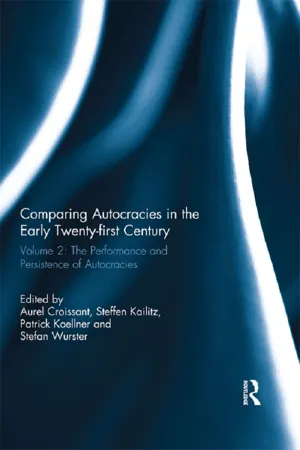![]()
Aurel Croissanta, Steffen Kailitzb, Patrick Koellnerc and Stefan Wursterd
aInstitute of Political Science, Heidelberg University, Germany; bHannah Ahrend Institute for Research on Totalitarianism, Dresden, Germany; cGIGA German Institute of Global and Area Studies, Hamburg, Germany; dInstitute of Political Science, Heidelberg University, Germany
The contributions in this second volume of Comparing Autocracies in the Early Twenty-first Century are united by the assumption that the performance of political regimes and their persistence are related. Furthermore, autocratic institutions and the specific configurations of elite actors within authoritarian regime coalitions induce dictators to undertake certain policies – different authoritarian institutions are therefore an important piece of the puzzle of government performance in dictatorships. Based on these two propositions, the contributions explore the differences between autocracies and democracies, as well as between different forms of non-democratic regimes, in regard to their outcome performance in selected policy fields; how political institutions affect autocratic performance and persistence; whether policy performance matters for the persistence of authoritarian rule (performance-persistence nexus); and what happens to dictators once autocratic regimes fall.
Introduction
While the first volume of Comparing Autocracies takes stock of the recent research on authoritarianism by addressing issues of conceptualisation and measurement of autocratic regimes as well as discussing the role of political institutions and strategies for maintaining (different forms of) autocratic rule,1 the contributions in this second volume explore the differences between autocracies and democracies, as well as between different forms of non-democratic regimes, in regard to their outcome performance in selected policy fields.2
The starting point for this volume is the observation that systematic research on the policy performance of these regimes continues to be scarce. The few existing studies of the policy performance of autocracies have usually tackled the effect of regime type by using indices that rank countries on a scale from perfect democracy to absolute autocracy,3 thus ignoring the substantial differences between various forms of autocracy.4 As a result, these studies are of limited use for answering the question of whether there are significant and systematic differences between different types of non-democratic regimes in their outcome performance in a variety of policy fields including economic, environmental, social, foreign or domestic security policy. This contrasts with the well-established research on institutional determinants of political performance in various types of democracy (Roller in this volume).
New classifications of autocracies have emerged in recent years which allow differentiations within the category of autocracies. The new data sets can be used to systematically compare output and outcome performance of policies within different types of dictatorship and subtypes of democracy. Moreover, data accessibility has improved significantly for various policy outcome variables. The contributions in this volume demonstrate this last point.
This second volume of Comparing Autocracies deals not just with the performance analysis of political regimes. Rather, it is based on the assumption shared by the contributors that the performance of political regimes and their persistence are related.5 This assumed performance-persistence nexus draws on the observation that bad policy performance (particularly in terms of failing to solve economic crises, as happened for instance to the member states of the former Soviet bloc) can contribute to the collapse of a political regime, whereas good policy performance may be a source for regime persistence and survival.
Against this background the contributions in this volume focus on the following two core questions:
1. What are the differences between autocracies and democracies, as well as between different forms of autocracies, in regard to their outcome performance in selected policy fields, and are these differences related to the type of authoritarian regime? This question aims at exploring the institutional conditions that shape dictators’ incentives and induce them to undertake specific policies in a variety of categories of government performance, e.g. social, environmental and economic performance.
2. Does policy performance matter for the persistence of a political regime? This question aims at integrating the “performance factor” into the current debate on the survival of autocracies by asking if and how policy performance affects their survival abilities.
The necessity of distinguishing different forms of autocracies
Although they diverge in terms of the perspectives taken, the contributions in this volume all share two basic assumptions. First of all, the prevalent dichotomy of democracy–dictatorship is of limited use for studying patterns of performance and persistence across political regimes. For example, one of the central questions in comparative political economy concerns the effects of regime types on economic performance. Since the 1960s, there has been extensive research on the question of whether democracy or autocracy is better for economic growth.6 The conclusions, however, remain mixed.7 But scholars who contend that, on average, democracies perform better argue that democratic institutions serve the function of constraining political leaders’ discretion and shaping rulers’ incentives in a way that promotes more growth-enhancing policies.8 Hence, democratic experience is positively associated, at least in the long-term, with stronger economic performance9 and with higher government effectiveness on other key indicators such as security, child mortality rates, education, life expectancy and access to drinking water.10 Autocracies, on the other hand, are expected to do uniformly poorly. They tend to promote growth retarding policies because dictators face less credible constraints on discretionary and predatory behaviour.11
A glance at the average growth rates in autocracies and democracies over the time span 1950–2000 – however without including any control variables – shows that democracies exhibit slightly higher growth rates than autocracies. However, the gap is less substantial than often assumed (Table 1).
More importantly for the topic here is the observation that the standard deviation of economic growth rates in autocracies seems to be much greater than in democracies. Table 1 shows that dictatorships vary far more in terms of economic growth rates than democracies. The group of autocratic high performers includes not only developmental dictatorships in East Asia, such as Singapore, South Korea, Indonesia and Taiwan and, in recent decades, the Peo...
